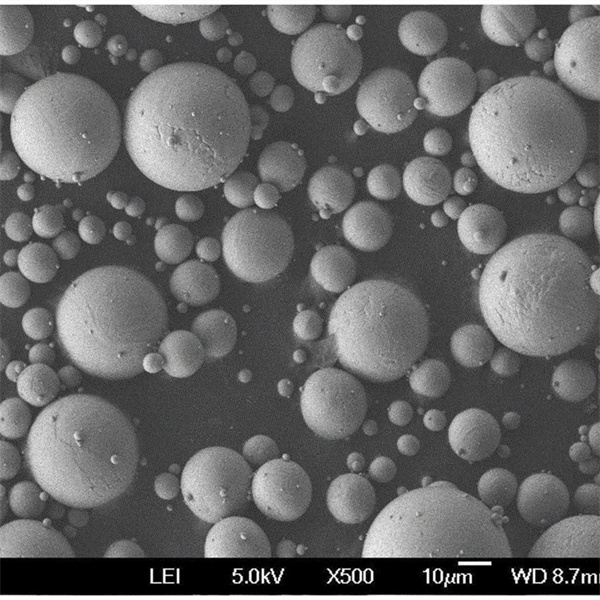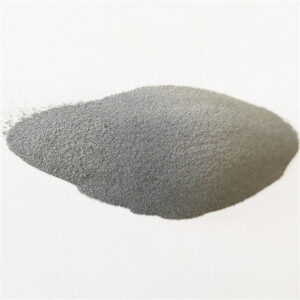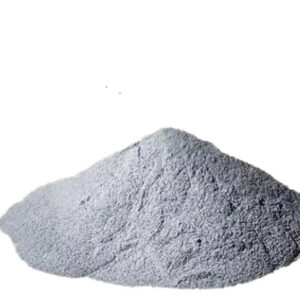Serbuk logam Niobium telah menemukan penggunaan yang meluas di seluruh perangkat medis, elektronik, optik, kedirgantaraan, dan bidang canggih lainnya dalam beberapa tahun terakhir. Panduan ini membahas secara mendalam tentang bubuk niobium bulat yang dirancang khusus untuk memberikan sifat dan kinerja yang lebih baik.
Kami akan mensurvei segala sesuatu mulai dari komposisi dan karakteristik hingga metode produksi, aplikasi, pemasok, spesifikasi, biaya, dan banyak lagi seputar bahan unik ini. Mari kita mulai!
Pengantar Bubuk Niobium Bulat
Niobium, juga dikenal sebagai columbium, berada di samping logam saudaranya, tantalum, dalam kelompok 5 tabel periodik. Niobium murni menawarkan kombinasi sifat yang langka:
- Kepadatan rendah tetapi kekuatan tinggi
- Stabilitas termal dan ketahanan oksidasi
- Superkonduktivitas pada suhu rendah
- Kompatibilitas dengan jaringan hidup
Hal ini membuat niobium menjadi bahan khusus yang penting saat ini. Dan menggunakan logam dalam bentuk bubuk bulat membuka kemampuan tambahan.
Manfaat Morfologi Bola
Partikel niobium bulat secara mikroskopis memiliki aliran dan penanganan yang lebih baik dibandingkan serpihan yang tidak beraturan. Bentuk bulat juga meningkatkan kepadatan kemasan.
Ini berarti, bubuk bola dapat dicetak, disinter, dan diproses dengan lebih baik secara keseluruhan. Kami akan meninjau kembali keunggulan ini secara lebih rinci nanti. Tetapi pertama-tama, mari kita menganalisis lebih lanjut komposisi dan produksi bubuk niobium bulat.

Komposisi Serbuk Niobium
Logam niobium murni memiliki kegunaan khusus. Tetapi paduan dan senyawa berbasis niobium memperluas aplikasi lebih jauh melalui sifat material yang dioptimalkan.
Jenis Paduan Niobium Utama:
| Paduan | Elemen Utama | Properti Penting |
| Niobium tingkat vakum | Nb + N / O / C / H | Kemurnian tertinggi |
| Paduan Nb-Zr | Nb + Zr | Penguatan curah hujan |
| Paduan Nb-Ti | Nb + Ti | Superkonduktivitas |
| Niobium nitrida | NbN | Kekerasan, konduktivitas |
- Niobium tingkat vakum bertujuan untuk tingkat kemurnian tertinggi dengan elemen lain yang dibatasi hanya 10-an ppm
- Zirkonium, titanium, dan molibdenum yang dipadukan dengan niobium menghasilkan material yang dikeraskan dengan presipitasi
- Bahan keramik niobium nitrida yang dibentuk oleh penyerapan nitrogen selama sintering meningkatkan kekerasan
Metode Produksi:
| Metode | Deskripsi |
| Peleburan Busur Vakum | Peleburan ingot Nb murni dalam wadah berpendingin air di bawah vakum dan peleburan ulang untuk mencapai padatan yang homogen |
| Peleburan Berkas Elektron | Menggunakan berkas elektron sebagai sumber panas berintensitas tinggi untuk melelehkan dan meneteskan niobium cair di bawah atmosfer vakum menjadi tetesan-tetesan halus |
| Hidrogenasi-Dehidrogenasi | Mereaksikan bubuk niobium dengan gas hidrogen pada suhu hingga 600°C untuk membuat bubuk NbH dan kemudian menghilangkan hidrogennya |
Serbuk Nb bulat yang diproses secara vakum menawarkan kemurnian kimiawi yang tinggi, yang penting untuk performa. Sekarang mari kita menganalisis karakteristik fisik utama.
Properti dari Bubuk Niobium Bulat
Morfologi bola yang dioptimalkan menyelaraskan sifat fisik, kimia, mekanik, listrik, dan sifat kinerja lainnya. Karakteristik serbuk yang tepat tergantung pada aplikasi yang dimaksudkan.
Tetapi ciri-ciri umum dari serbuk niobium bulat terkemuka meliputi:
Distribusi Ukuran Partikel
- Kisaran ukuran tipikal antara 1-250 mikron
- Ukuran partikel rata-rata 10-45 mikron lebih disukai
- Ukuran partikel yang dapat dikontrol dan distribusi yang ketat
- Meminimalkan konten satelit di bawah 5%
Bentuk Partikel
- Morfologi yang sangat bulat
- Permukaan bedak yang halus
- Konsistensi bentuk dari batch ke batch
- Struktur internal yang solid dengan porositas rendah
- Homogen secara kimiawi di seluruh bagian
Aliran Serbuk
- Laju aliran yang sangat baik, biasanya> 25 detik/50g
- Penanganan aliran fluida hingga ukuran sub-mikron
- Mencampur dan menyatu secara merata dengan bubuk lainnya
- Berbagai macam kepadatan pengepakan dapat dicapai
Tingkat Kemurnian
- Oksigen di bawah 200 ppm
- Nitrogen di bawah 50 ppm
- Karbon di bawah 250 ppm
- Tidak ada inklusi nitrida atau karbida
- 99,99% konten Nb murni atau lebih baik
Kepadatan
- Kepadatan yang tampak dari 2-12 g/cm3
- Kerapatan keran mencapai 70% dari kerapatan padat Nb murni
- Kepadatan sebenarnya 8,57 g/cm3
Dengan wawasan yang lebih dalam tentang komposisi, manufaktur, dan atribut bubuk bola, sekarang mari kita jelajahi beberapa aplikasi utama yang memanfaatkan keunggulan unik ini.
Aplikasi Bubuk Niobium Bulat
Aerospace dan pertahanan
- Mesin dan turbin berkinerja tinggi
- Braket struktural yang ringan
- Komponen rudal
- Penyerapan radar
- Sub-sistem satelit
Ilmu Pengetahuan Kuantum
- Magnet superkonduktor
- Komputasi kuantum
- Target akselerator partikel
- Agen kontras MRI
- Pelacak medis
Elektronik
- Kapasitor dan resistor
- Antena 5G
- Film konduktif
- Tabung vakum
- Pemandu gelombang
Optik
- Lensa kamera
- Tinta keamanan
- Filter optik
- Lapisan anti-reflektif
Pengolahan Kimia
- Tanaman asam
- Produksi klorida
- Katalis
- Kemenangan logam
Energi
- Reaktor nuklir
- Eksperimen fusi
- Penyimpanan hidrogen
- Bahan baterai
Kemampuan unik Niobium sangat cocok untuk aplikasi tingkat lanjut seperti superkonduktor, peralatan medis, paduan khusus, optik, elektronik, dan produksi bahan kimia.
Menghasilkan kinerja niobium yang menjanjikan dalam produk dimulai dengan bahan baku serbuk bulat yang dioptimalkan untuk proses fabrikasi seperti metal AM atau sintering.
Sekarang, mari kita tinjau teknik populer untuk membuat komponen berbasis niobium yang presisi dari serbuk bola.
Fabrikasi dengan Serbuk Niobium Bulat
Morfologi bola khusus dan distribusi ukuran yang ketat dari serbuk niobium yang direkayasa menyesuaikannya untuk kebutuhan fabrikasi modern:
Manufaktur Aditif
- Peleburan laser selektif (SLM)
- Peleburan berkas elektron (EBM)
- Pengaliran pengikat
- Fusi lapisan serbuk laser (PBF)
- Deposisi energi yang terarah
Pemrosesan Bubuk Konvensional
- Tekan dan sinter
- Pengepresan isostatik panas (HIP)
- Cetakan injeksi logam (MIM)
- Semprotan termal
- Granulasi
Manfaat Teratas dari Bubuk Bulat
- Peningkatan kepadatan kemasan untuk mengurangi porositas
- Aliran dan penyebaran bubuk yang ditingkatkan
- Pemanasan yang lebih seragam dan dinamika kolam lelehan
- Mengurangi tegangan sisa dan keretakan
- Ikatan interlayer yang baik meningkatkan hasil akhir permukaan
- Hasil produksi yang lebih tinggi
Partikel bulat 3D mencetak komponen niobium berkualitas lebih baik dengan resolusi yang baik, geometri presisi, struktur mikro yang terkendali, dan fitur interior yang dapat disesuaikan.
Keuntungan yang sama juga berlaku untuk menekan dan menyinter serbuk niobium menjadi komponen berkinerja tinggi.
Sekarang mari kita menyoroti beberapa pemasok global terkemuka yang menyediakan bubuk niobium bulat berkualitas saat ini.
Terkemuka Bubuk Niobium Bulat Pemasok
| Produser | Penunjukan Produk |
| CBMM | Serbuk mikro dan nano niobium dengan kemurnian tinggi |
| Solusi HC Starck | Niobium murni dan paduan niobium |
| H.C. Starck Tantalum dan Niobium | Serbuk niobium berbentuk bola |
| ESPICorp | Serbuk niobium hidrida dengan kemurnian sangat tinggi |
| Elemen Amerika | Serbuk dan senyawa logam Niobium |
Produsen serbuk logam utama ini menawarkan keahlian yang luas dalam menangani niobium dan paduannya. Kemampuan produksi internal yang unik juga memungkinkan morfologi serbuk yang disesuaikan.
Sekarang mari kita periksa metrik kualitas utama dan standar kepatuhan yang disyaratkan oleh spesifikasi bubuk niobium.
Spesifikasi Serbuk Niobium
Aplikasi menuntut konsistensi. Jadi, metode uji standar dari organisasi seperti ASTM membantu menentukan dan mengontrol kualitas bubuk niobium bulat:
Baku mutu:
| Organisasi | Metode Uji Standar |
| ASTM | B809, B829, F3049 |
| ISO | 4497-2 |
Ini mencakup metrik penting seperti:
- Distribusi ukuran partikel
- Morfologi bubuk dan luas permukaan
- Kerapatan tampak dan kerapatan tekan
- Laju aliran melalui corong tetap
- Kerugian saat pengapian
- Uji kimia
- Analisis fase
Memenuhi kebutuhan aplikasi membutuhkan kontrol yang ketat terhadap karakteristik bubuk ini. Pemasok niobium global terkemuka memiliki sistem kualitas yang menerapkan versi terbaru dari metode pengujian ini.
Sekarang mari kita periksa pertimbangan biaya bubuk niobium.
Harga Bubuk Niobium
Sebagai logam minor khusus, niobium memiliki harga yang lebih tinggi karena kelangkaan bahan baku dan kerumitan pemrosesan. Meskipun demikian, niobium memberikan performa yang tak tertandingi per ponnya dalam banyak kasus.
Faktor-faktor yang Mempengaruhi Harga:
- Tingkat kemurnian - Dari 98% hingga 99,99%
- Kisaran ukuran bubuk - Skala nano lebih mahal
- Jumlah pesanan - Pembelian dalam jumlah besar menghemat 20-40%
- Waktu pengiriman - "Biaya ekspres" giliran cepat
- Pengujian validasi tambahan
Contoh Biaya:
- 99% bubuk niobium 2-7 mikron murni - $200-$500 per kg
- 99,8% bubuk nano niobium murni <250 nm - $1000-$2000 per kg
Meskipun biayanya melebihi logam biasa, sifat uniknya membenarkan penggunaan niobium di mana kinerja menjadi hal yang paling penting. Dan serbuk daur ulang juga dapat mengimbangi biaya.
Sekarang mari kita jawab beberapa pertanyaan umum tentang bubuk niobium.
Pertanyaan Umum
Berikut ini adalah jawaban atas beberapa pertanyaan yang sering diajukan tentang materi unik ini:
Dengan apa niobium terutama dipadukan untuk meningkatkan sifat yang berbeda?
Paduan niobium yang umum termasuk NbTi untuk superkonduktivitas, NbZr untuk kekuatan, NbMo untuk penggunaan suhu tinggi, dan keramik NbN untuk kekerasan dan konduktivitas.
Apa manfaat dari bubuk niobium kelas vakum?
Kemurnian sangat tinggi dengan lebih sedikit kontaminan memungkinkan pencapaian sifat intrinsik terbaik niobium secara andal - kepadatan, kekuatan, konduktivitas, superkonduktivitas, dll.
Mengapa kemampuan mengalir penting untuk bubuk niobium yang ditujukan untuk penggunaan AM atau sintering?
Aliran bubuk yang baik memastikan penyebaran yang sangat baik dan lapisan seragam yang diperlukan untuk mengemas partikel dengan rapat. Hal ini meminimalkan cacat saat pencetakan 3D atau pengepresan/sintering.
Apa yang dimaksud dengan penggetasan hidrogen dan mengapa hal ini menjadi perhatian untuk aplikasi niobium?
Selama pemanasan, sisa hidrogen dari proses produksi bubuk dapat membuat beberapa logam menjadi rapuh. Degassing vakum dan penanganan niobium secara hati-hati dilakukan untuk mencegah hal ini.
Bagaimana niobium didaur ulang setelah digunakan dalam aplikasi seperti pemindai medis superkonduktor?
Teknik pemulihan seperti hidridasi memungkinkan niobium direklamasi dan direduksi menjadi bubuk untuk digunakan kembali. Hal ini menghemat sumber daya sekaligus memenuhi permintaan.







